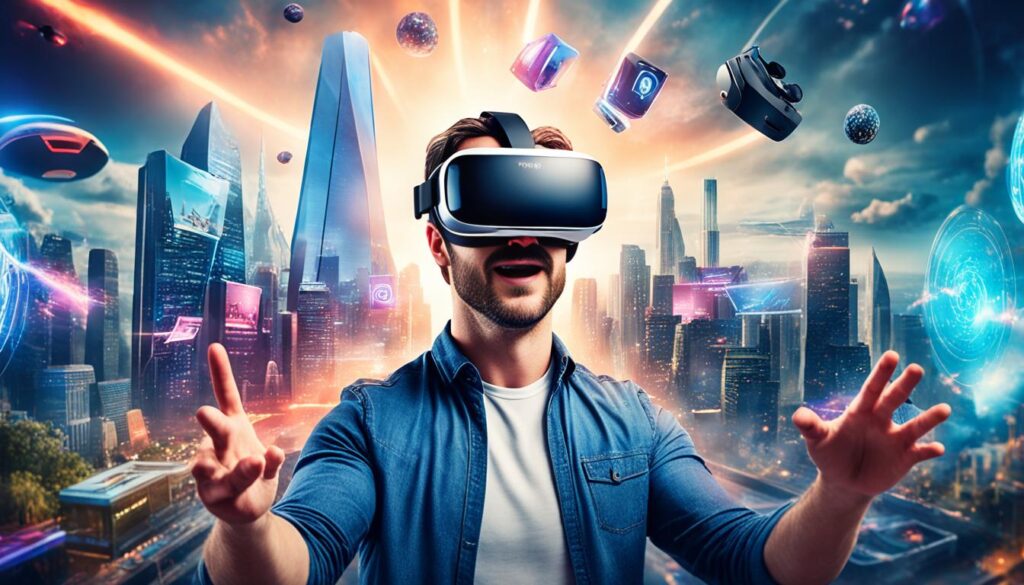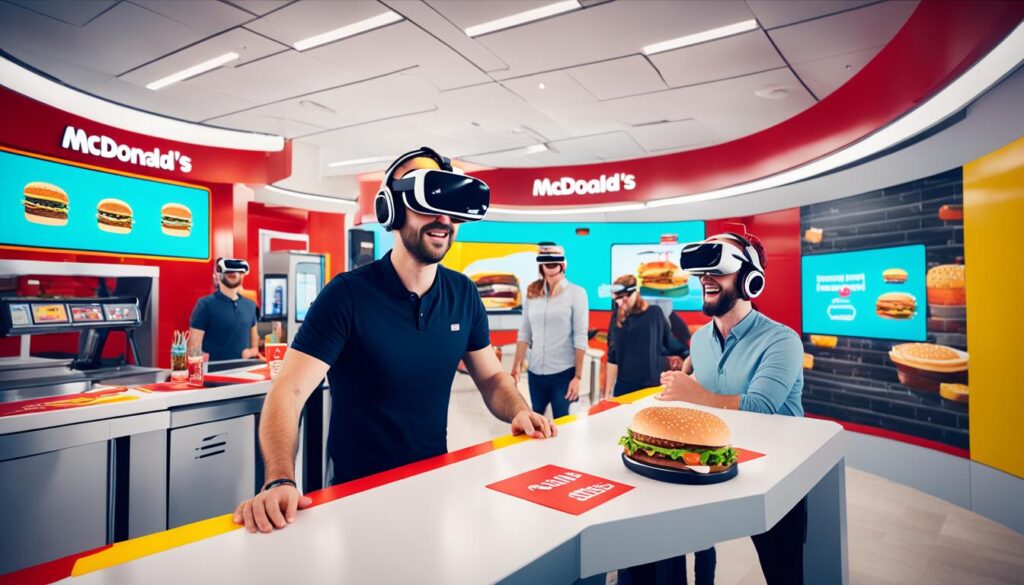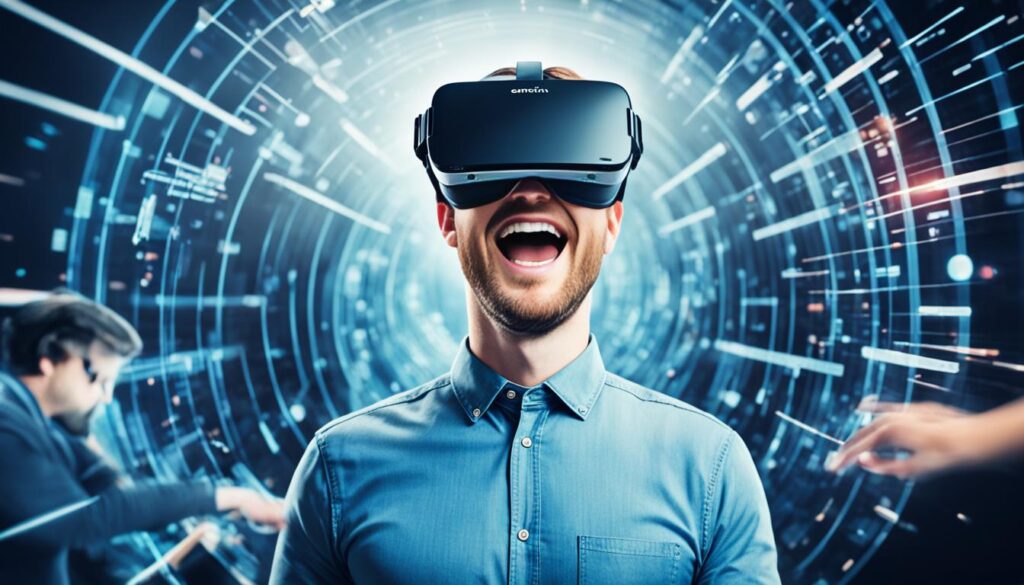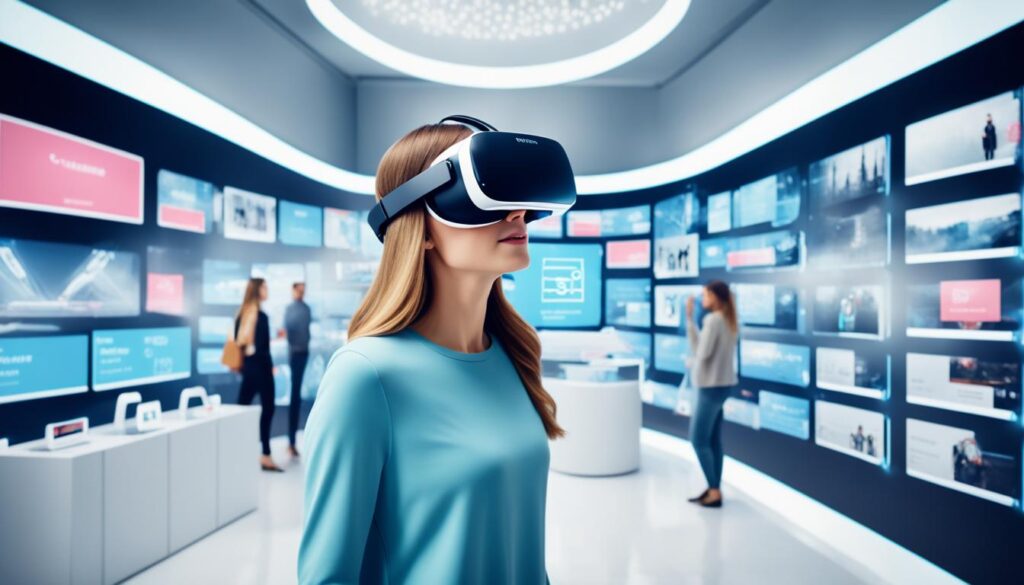Virtual reality (VR) has revolutionized the marketing landscape, offering businesses exciting opportunities to enhance customer engagement and elevate their brand experiences. By integrating VR technology into their marketing strategies, businesses can create immersive and personalized experiences that leave a lasting impact on customers.
In this article, we will explore how big data and virtual reality marketing can boost customer experience and drive business growth. We will delve into the benefits and challenges of VR integration, examine successful case studies, and discuss the evolution of customer experience in the digital commerce industry. Additionally, we will explore how businesses can leverage technology and data analytics to deliver personalized customer experiences.
Key Takeaways:
- Big data and virtual reality marketing can enhance customer engagement and elevate brand experiences.
- Implementing VR technology may require specialized skills and resources, but the benefits outweigh the challenges.
- Successful case studies, such as IKEA, North Face, Red Bull, McDonald’s, and Mercedes-Benz, demonstrate the effectiveness of VR in marketing.
- The digital commerce industry has shifted towards prioritizing customer experience to ensure brand loyalty and retention.
- Data analytics, AI-powered chatbots, and omnichannel strategies can be used to deliver personalized customer experiences.
The Opportunities of Virtual Reality in Marketing
Virtual reality offers businesses the opportunity to create immersive brand experiences that transport customers to a different world. It enhances customer engagement by allowing them to explore and interact with products in unique ways. With virtual reality, businesses can go beyond traditional marketing methods and create memorable experiences that capture customers’ attention.
One of the key advantages of virtual reality in marketing is the ability to conduct virtual product demonstrations. Instead of relying on traditional methods, businesses can use VR to showcase their products and allow customers to experience them firsthand. Virtual demonstrations provide a realistic and interactive experience, enabling customers to make more informed purchase decisions.
Additionally, virtual reality enables businesses to forge emotional connections with customers. By creating immersive experiences that evoke emotions, businesses can leave a lasting impression on their target audience. Whether it’s taking customers on a virtual adventure or allowing them to try out different scenarios, VR increases the level of engagement and emotional investment in a brand.
Moreover, virtual reality facilitates customized and personalized experiences. By leveraging VR technology, businesses can provide tailored experiences that cater to individual preferences and needs. From personalized virtual shopping experiences to customizing virtual environments, VR allows businesses to deliver unique and memorable interactions that differentiate them from competitors.
| Benefits of Virtual Reality in Marketing | |
|---|---|
| 1. Immersive brand experiences | Transport customers to a different world and create lasting impressions. |
| 2. Enhanced customer engagement | Allow customers to explore and interact with products in unique ways. |
| 3. Virtual product demonstrations | Showcase products in a realistic and interactive manner. |
| 4. Emotional connections | Evoke emotions and create memorable experiences. |
| 5. Customized and personalized experiences | Cater to individual preferences and provide tailored interactions. |
A successful example of virtual reality in marketing is the IKEA VR Experience. Through this immersive application, customers can virtually explore and interact with different kitchen designs, gaining a deeper understanding of IKEA’s products and making informed decisions. This showcases how virtual reality can enhance customer engagement and facilitate virtual product demonstrations.

Key Takeaways:
- Virtual reality enables businesses to create immersive brand experiences that transport customers to a different world.
- It enhances customer engagement by allowing them to explore and interact with products in unique ways.
- Virtual reality enables virtual product demonstrations, providing realistic and interactive experiences for customers.
- Businesses can forge emotional connections with customers, creating lasting impressions and building brand loyalty.
- Virtual reality facilitates customized and personalized experiences, catering to individual preferences and needs.
By leveraging virtual reality in their marketing strategies, businesses can elevate their customer experiences, enhance engagement, and differentiate themselves in today’s competitive marketplace.
The Challenges of Virtual Reality in Marketing
Implementing VR in marketing campaigns can pose several challenges that businesses need to navigate for successful implementation. These challenges include:
1. High Cost of Implementation
Integrating virtual reality technology into marketing campaigns can be expensive. The cost of VR devices, software development, and hardware upgrades can significantly impact a company’s budget. Companies must carefully weigh the potential return on investment before committing to VR implementation.
2. Technical Limitations
VR technology is continuously evolving, but it still has certain limitations. For example, the resolution of VR headsets may not match the clarity of real-life visuals, which can affect the overall immersive experience for customers. Similarly, VR devices may have limited battery life or processing power, which can impact the performance and usability of VR marketing experiences.
3. Compatibility Issues
Compatibility between different VR devices, software platforms, and hardware components can pose challenges for businesses. Creating VR marketing experiences that work seamlessly across multiple devices and platforms requires careful design and testing to ensure a consistent and immersive experience for all customers.
4. Lack of Awareness and Adoption
Not all customers may be aware of or have access to VR devices, limiting the potential reach of VR marketing campaigns. Furthermore, some customers may be hesitant to adopt VR technology due to concerns about its complexity or potential side effects. This lack of awareness and limited adoption can hinder the widespread success of VR marketing initiatives.
5. Need for Skilled Personnel
Implementing VR in marketing campaigns requires specialized technical skills and expertise. Businesses need professionals who can develop VR content, optimize performance, and troubleshoot technical issues. However, finding and retaining skilled personnel with experience in VR can be challenging, as the demand for these professionals is high.
6. Privacy and Security Concerns
VR experiences often involve collecting and processing customer data. Businesses must address privacy and security concerns to protect customer information and comply with data protection regulations. Ensuring the secure transmission and storage of data within VR applications is crucial to maintaining customer trust and reputation.
Despite these challenges, businesses that successfully overcome them can harness the power of virtual reality to create immersive and engaging marketing experiences for their customers.
Successful Case Studies of VR in Marketing
When it comes to successful implementation of virtual reality (VR) in marketing, several prominent brands have set a benchmark with their innovative approaches. Let’s explore some captivating case studies that demonstrate how VR can enhance customer engagement and brand awareness.
IKEA VR Experience
IKEA, the renowned furniture retailer, leveraged VR technology to offer customers a mesmerizing experience of exploring and customizing virtual kitchens. By immersing customers in a realistic virtual environment, IKEA allowed them to visualize their dream kitchens and make informed design choices without physically visiting the store. This unique VR experience not only boosted customer engagement but also simplified the complex decision-making process.
North Face VR Experience
North Face, a leading outdoor apparel company, introduced a thrilling VR experience that took customers on a virtual rock climbing adventure. By simulating the thrill and adrenaline rush of scaling a mountain, North Face effectively conveyed its brand essence and encouraged customers to embrace adventure. This immersive VR experience not only strengthened the emotional connection between North Face and its customers but also boosted brand loyalty.
Red Bull VR Experience
Red Bull, the renowned energy drink brand, created an exhilarating VR skydiving experience. By immersing users in a virtual world, Red Bull captured the essence of extreme sports and provided customers with a taste of the adrenaline-fueled lifestyle associated with its brand. This VR experience showcased Red Bull’s commitment to pushing boundaries and engaging with its target audience in an innovative way.

McDonald’s VR Experience
McDonald’s, the global fast-food chain, capitalized on VR technology to showcase a virtual restaurant experience. By allowing customers to explore a virtual McDonald’s and interact with various menu items, the brand successfully created a unique and immersive dining experience. This VR initiative enabled McDonald’s to capture customers’ attention and generate excitement around its offerings in a dynamic digital space.
Mercedes-Benz VR Experience
Mercedes-Benz, the luxury car manufacturer, sought to provide customers with a virtual test drive experience. By offering customers the opportunity to experience their desired vehicles virtually, Mercedes-Benz integrated VR seamlessly into their marketing strategy. This immersive VR experience enabled customers to visualize themselves behind the wheel of a Mercedes-Benz, enhancing their engagement with the brand and driving a deeper emotional connection.
These captivating case studies demonstrate the power of VR in marketing. From customizable kitchen experiences to thrilling virtual adventures, the successful implementation of VR by IKEA, North Face, Red Bull, McDonald’s, and Mercedes-Benz showcases the immense potential VR holds for enhancing customer engagement, fostering emotional connections, and increasing brand awareness.
The Evolution of Customer Experience in Digital Commerce
The digital commerce industry has undergone significant changes in response to advancements in technology and evolving customer needs. In this digital era, businesses are recognizing the importance of prioritizing customer experience to gain a competitive edge. Factors like brand loyalty, customer retention, and online shopping have reshaped the retail landscape, making it crucial for businesses to adopt a customer-centric approach.
The rapid advancements in technology have revolutionized the way customers interact with brands and make purchase decisions. With the rise of smartphones, social media, and other digital platforms, customers have easy access to information and expect a seamless online shopping experience. This shift in customer behavior necessitates businesses to adapt and cater to the changing customer needs.
Brand loyalty, once a strong driver of customer retention, has become weaker in the digital commerce landscape. With an abundance of choices and easy access to alternative options, customers are more likely to switch brands if their expectations are not met. As a result, businesses face the challenge of not only attracting new customers but also retaining existing ones.
Online shopping has transformed the retail industry, offering customers the convenience of purchasing products from the comfort of their homes. This shift has significantly increased competition among businesses, forcing them to provide exceptional customer experiences to differentiate themselves. The availability of a wide range of products, competitive pricing, and seamless purchasing processes have become the new norm, and businesses must continuously meet these expectations to stay relevant.
Adopting a customer-centric approach is crucial in today’s digital commerce landscape. It requires businesses to prioritize customer satisfaction, understand their needs, and tailor their products and services accordingly. By putting the customer at the center of their strategies, businesses can enhance customer retention, build brand loyalty, and ultimately drive sustainable growth.
To thrive in the digital commerce industry, businesses need to continuously adapt to the evolving customer landscape and leverage advancements in technology. Embracing AI-powered solutions, data analytics, and personalized marketing strategies can help businesses gain valuable insights into customer preferences and deliver customized experiences. By analyzing customer data, businesses can identify patterns, preferences, and trends to better understand their target audience and provide personalized recommendations and offerings.
The Evolution of Customer Experience in Digital Commerce
| Factors | Implications |
|---|---|
| Advancements in Technology | Enables seamless online shopping experiences and personalized marketing strategies. |
| Changing Customer Needs | Demands a customer-centric approach and tailored solutions to meet evolving expectations. |
| Brand Loyalty | Requires businesses to focus on building and maintaining customer loyalty in a highly competitive market. |
| Customer Retention | Raises the challenge of retaining customers through exceptional experiences and personalized offerings. |
| Online Shopping | Transforms the retail industry and necessitates a strong online presence and seamless purchasing processes. |
| Customer-Centric Approach | Encourages businesses to prioritize customer satisfaction and tailor their strategies accordingly. |
By embracing these advancements and a customer-centric approach, businesses can not only meet but exceed customer expectations. This will result in improved customer retention, enhanced brand loyalty, and increased customer satisfaction, ultimately driving growth and success in the digital commerce landscape.

Leveraging Technology for Personalized Customer Experiences
Businesses today have the opportunity to create highly personalized customer experiences by leveraging the power of technology. By incorporating data analytics and AI into their strategies, businesses can gather valuable insights and optimize user experiences across various touchpoints. Let’s explore the key technologies that enable personalized customer experiences.
Data Analytics: Unlocking Customer Insights
Data analytics is at the core of personalized customer experiences. By analyzing customer data, businesses can gain valuable insights into their preferences, behaviors, and purchasing patterns. This data enables businesses to segment their customer base, identify trends, and tailor their offerings to meet individual needs. With a deeper understanding of their customers, businesses can deliver personalized recommendations, promotions, and offers that resonate with each customer segment.
AI and Chatbots: Creating Seamless Customer Support
Artificial intelligence (AI) has revolutionized customer support by introducing chatbot technology. AI-powered chatbots provide efficient and effective customer support, addressing customer queries and resolving issues in real-time. By leveraging natural language processing capabilities, chatbots can understand and respond to customer inquiries, freeing up human resources and ensuring round-the-clock support. This personalized and instant assistance enhances the overall customer experience, boosting satisfaction and loyalty.
Omnichannel Strategy: Seamless Customer Journeys
In today’s digital landscape, customers interact with businesses across multiple channels. An effective omnichannel strategy ensures a seamless customer journey by integrating various touchpoints and creating a cohesive brand experience. Whether customers engage with a business through a website, social media, or a physical store, maintaining consistent messaging and personalization is crucial. By leveraging technology, businesses can synchronize customer data and interactions, providing a personalized and unified experience across channels.
Augmented and Virtual Reality: Immersive Experiences
Augmented reality (AR) and virtual reality (VR) technologies have introduced new dimensions to personalized customer experiences. AR enables customers to visualize products in their own environments, while VR transports them to immersive virtual worlds. By leveraging these technologies, businesses can offer personalized shopping experiences, allowing customers to try products virtually or explore virtual showrooms. These immersive experiences enhance customer satisfaction and increase conversion rates.
By leveraging data analytics, AI, omnichannel strategies, and AR/VR technologies, businesses can create highly personalized customer experiences that drive engagement, satisfaction, and loyalty.

Conclusion
The digital landscape is rapidly evolving, and businesses must adapt to stay competitive. The future of customer experience lies in digital transformation, where technologies like AI and ML play a crucial role in driving automation and enhancing the customer experience suite. By leveraging AI, businesses can predict customer needs and preferences, enabling them to deliver personalized experiences at scale.
Virtual reality has also emerged as a powerful tool for showcasing products and services. By immersing customers in virtual experiences, businesses can create emotional connections and offer unique and personalized interactions. This technology opens up new opportunities for engagement and differentiation.
Focusing on customer experience strategy is essential for businesses looking to gain a competitive advantage. By placing the customer at the center of their operations and incorporating trusted AI technologies, businesses can deliver seamless and personalized experiences that meet and exceed customer expectations. The use of customer journey mapping and data and AI consulting services can help businesses harness the power of data and technology to transform the customer lifecycle.
In the era of digital transformation, providing a seamless and enjoyable customer journey is key to driving higher conversion rates and standing out in the crowded online marketplace. By embracing digital technologies, adopting a customer-centric approach, and leveraging data and AI, businesses can position themselves for success in the ever-evolving world of customer experience.
FAQ
What is big data and virtual reality (VR) marketing?
Big data and virtual reality (VR) marketing combines the use of data analytics strategies and VR technology to enhance customer experience and engagement, optimize customer journey, and make data-driven marketing decisions.
How can virtual reality enhance customer engagement in marketing?
Virtual reality allows businesses to create immersive brand experiences, enabling customers to explore and interact with products, conduct virtual product testing, create emotional connections, and provide personalized experiences.
What are the challenges of implementing virtual reality in marketing?
Implementing virtual reality in marketing campaigns can be costly and require specialized technical skills. There are also technical limitations, compatibility issues, and a lack of awareness and adoption among customers. Businesses must address these challenges and ensure compliance with privacy and security regulations.
Can you share some successful case studies of virtual reality in marketing?
Sure! Some successful case studies include IKEA’s virtual kitchen exploration and customization, North Face’s virtual rock climbing experience, Red Bull’s VR skydiving experience, McDonald’s virtual restaurant showcase, and Mercedes-Benz’s virtual vehicle experience.
How has customer experience evolved in digital commerce?
Advancements in technology and changing customer needs have led to a focus on customer experience in digital commerce. Maintaining customer satisfaction and retention is more challenging due to weaker brand loyalty and the transformation of the retail landscape through online shopping.
What technologies can businesses leverage to create personalized customer experiences?
Businesses can leverage data analytics and AI to create personalized customer experiences. By analyzing customer data, businesses can personalize user interfaces, promotions, and offers. AI-powered chatbots provide efficient customer support, and an omnichannel strategy ensures a seamless customer journey. Augmented and virtual reality technologies also enable personalized shopping experiences.
How can businesses benefit from digital transformation and customer experience strategy?
Digital transformation, incorporating technologies like AI and ML, can drive automation and enhance the customer experience. By focusing on customer experience strategy and incorporating trusted AI, businesses can gain a competitive advantage. Consulting services, such as customer journey mapping and data and AI consulting, can help businesses transform the customer lifecycle and differentiate themselves from competitors.








